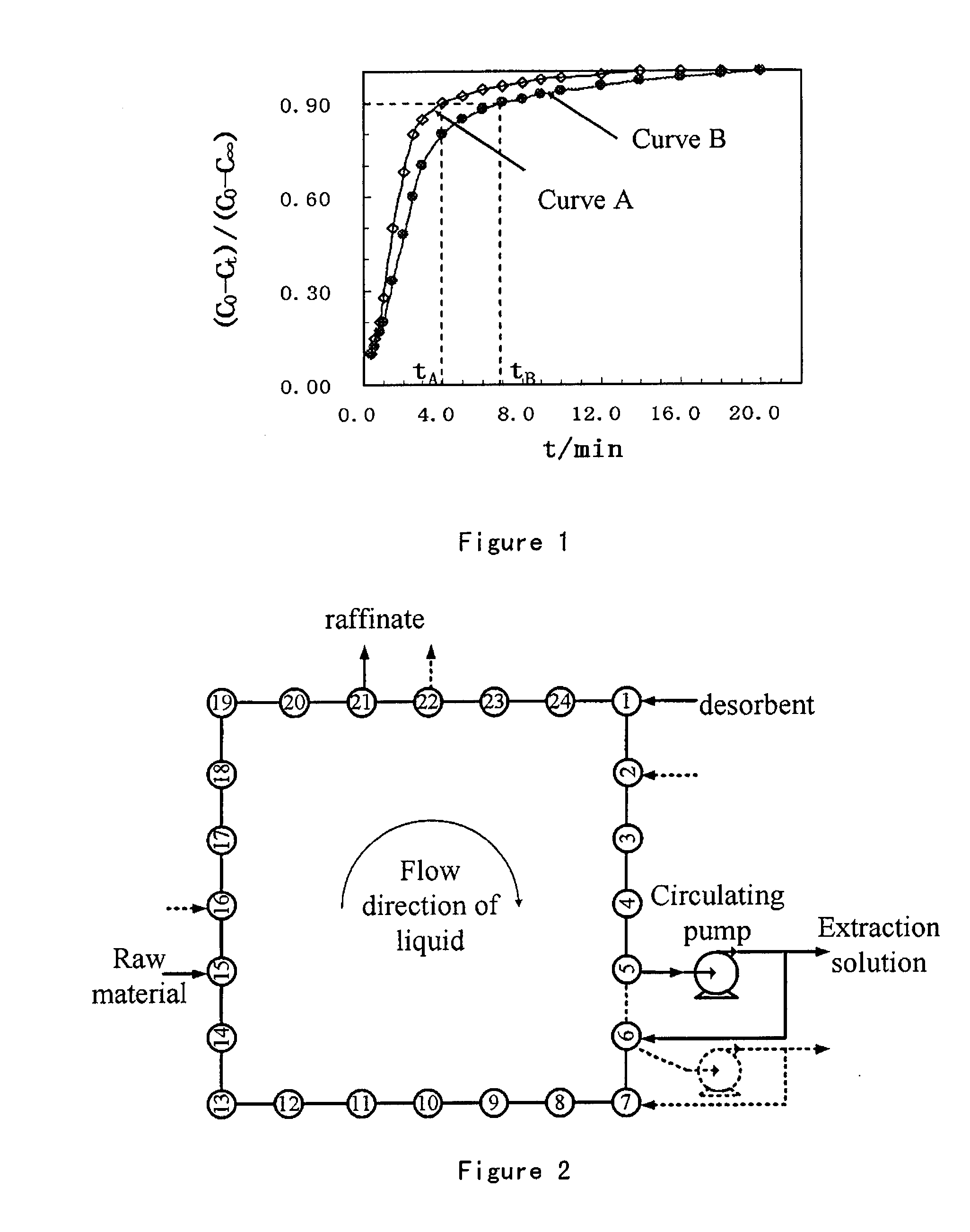Agglomerated zeolite adsorbents and process for producing the same
a technology of agglomerated zeolite and adsorbent, which is applied in the direction of physical/chemical process catalyst, bulk chemical production, other chemical processes, etc., can solve the problems of partial loss of adsorption capacity, difficulty in separating zeolite adsorbents using conventional rectification processes, etc., and achieve good mass transfer performance, high macropore proportion, and large pore volume
- Summary
- Abstract
- Description
- Claims
- Application Information
AI Technical Summary
Benefits of technology
Problems solved by technology
Method used
Image
Examples
example 1
[0037]The adsorbent of the present invention was prepared and its adsorptive performance was measured.
(1) Production of Zeolites X in Small Crystal Grains:
[0038]16.4 kg sodium meta-aluminate solution (the content of Al2O3 is 17.3 mass %, and the content of Na2O is 21.0 mass %), 11.0 kg deionized water and 2.9 kg sodium hydroxide were added into a 100 L synthesis tank. After solid base was completely dissolved under stirring, 11.8 kg sodium silicate solution (the content of SiO2 is 28.3 mass %, and the content of Na2O is 8.8 mass %) was added. The mixture was stirred until it was uniform, and stands for aging at 25° C. for 20 hours to give a guiding agent.
[0039]255 kg sodium silicate solution, 1001 kg deionized water and 37 kg sodium hydroxide were added into a 2000 L tank at 25° C., and they were sufficiently mixed under stirring. 227 kg sodium meta-aluminate was added under stirring, then 15 kg guiding agent was added. Keep stirring until uniform mixture was achieved. The mixture w...
example 2
[0043]The adsorbent was produced according to the procedure described in example 1, except that: in the step (2) for shaping by tumbling, 5.0 mass % aqueous ammonium carbonate solution was sprayed in an amount of 28 mass % based on the solid mixed power; in the step (3), the calcined pellets were treated with mixed solution of sodium hydroxide and sodium silicate for in-situ crystallization, wherein said mixed solution comprises 4.3 mass % of Na2O and 2.1 mass % of SiO2 and the toluene adsorption capacity of agglomerated pellets obtained after in-situ crystallization was 0.230 g / g, which was equivalent to 97.9 mass % of the content of zeolite X in agglomerated pellets. Adsorbent A-2 was obtained after ion-exchange and activation and was calcined at 600° C. for 2 hours, and the ignition loss was 4.5 mass %. The composition of the adsorbent, the volume and the size distribution of pores as measured by mercury porosimetry, and other physical properties were recorded in table 1.
example 3
[0044]The adsorbent was produced according to the procedure described in example 1, except that: in the step (2), 63 kg NaX zeolite as produced in example 1 was mixed homogeneously with 5.4 kg kaolin and 2.7 kg carboxymethyl cellulose (available from Qingquan Cellulose plant in Qingzhou, Shandong, China). The mixture was placed in turnplate, and sprayed with a suitable amount of aqueous solution of polyacrylamide (available from Henghao Innovation Amide Ltd., Shanghai, China) with a concentration of 2.0 mass % during tumbling to allow the solid mixed powder to be agglomerated into pellets. The amount of aqueous polyacrylamide solution sprayed during tumbling was 20 mass % of the solid mixed powder. Drying, calcination and in-situ crystallization were carried out according to the subsequent steps described in example 1. The toluene adsorption capacity of pellets obtained after in-situ crystallization was measured as 0.226 g / g, which was equivalent to 96.2 mass % of the content of zeo...
PUM
| Property | Measurement | Unit |
|---|---|---|
| Temperature | aaaaa | aaaaa |
| Temperature | aaaaa | aaaaa |
| Temperature | aaaaa | aaaaa |
Abstract
Description
Claims
Application Information
 Login to View More
Login to View More - R&D
- Intellectual Property
- Life Sciences
- Materials
- Tech Scout
- Unparalleled Data Quality
- Higher Quality Content
- 60% Fewer Hallucinations
Browse by: Latest US Patents, China's latest patents, Technical Efficacy Thesaurus, Application Domain, Technology Topic, Popular Technical Reports.
© 2025 PatSnap. All rights reserved.Legal|Privacy policy|Modern Slavery Act Transparency Statement|Sitemap|About US| Contact US: help@patsnap.com

